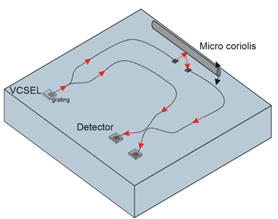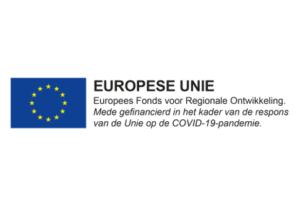SensorChip – About this project
In response to the Covid-19 pandemic, SensorChip project has developed new sensors meant to revolutionize the measurement of liquid and gas flows, analyse gas compositions, and detect biomarkers in body fluids with high accuracy. These innovations include a Micro-Coriolis flow sensor, a gas sensor for spectroscopical CO2 measurement, and a biosensor chip for detecting cancer biomarkers.
A Micro-Coriolis flow sensor has been developed to generate movement in a micro-tube using flowing liquids. The readout of this tube is collected using an optical method. A VCSEL source at 850 nm is used to reflect light off the tubes surface, and this light is then collected to determine the position of the tube. The position is related to the Micro-Coriolis movement, hence making an accurate flow sensor.
A gas sensor has been developed to measure CO2 gas spectroscopically. To accurately control the wavelength and make sure it is situated exactly on the CO2 absorption line, a hybrid tunable laser in the C-band was used. The Lambert-Beer law was used to determine concentration by measuring the absorption of light by CO2. The absorption occurs on-chip, featuring a folded waveguide longer than a meter onto a compact footprint. This design not only creates a sensitive sensor for this gas but also holds promise for other relevant gases, including methane (CH4).
The presence of biomarkers has been addressed in this project by the biosensor chip. Our asymmetric Mach-Zehnder Interferometer (aMZI) is used to detect markers of cancer in exceptional low concentrations. Enhanced sensitivity is achieved through a highly bio-specific assay, further boosted by a hybrid tunable laser operating around 850 nm. The development of instrumentation for scaling up these biosensors to meet future demands is also a key outcome.
Role of LioniX International:
In this project, LioniX International devised, designed, and fabricated the Photonic Integrated Circuits (PICs) required for all these sensors. The Micro-Coriolis position sensor is comprised of a chip which couples out the light perpendicularly using grating couplers, to determine the vertical position of the tube. An extended In-phase Quadrature technique is used to accurately determine the position while being less susceptible to intensity variations. Gas spectroscopy is performed using Evanescent Wave Spectroscopy, where the gas interacts directly with the light near the waveguide surface and its absorption can be determined. Similarly, in the biosensor the light directly interacts with the biological processed occurring on the waveguide surface. LioniX International’s aMZI biosensor has been employed in this application for the extreme sensitivity it provides for the detection of early signs of cancer. Lastly, several external cavity hybrid lasers have been made to generate the required laser light for these applications.





